Tactical Air Rifles and Optics

This model of the Sig Sauer MCX tactical air rifle is based on the military version with noise suppressor and solid shoulder stock (which is used to house the 88 gram CO2 cylinder). To match it with the actual 5.56mm military version I have also equipped it with the Sig Sauer Bravo4 4x30mm Battle Sight. The Sig Sauer optic is the same used by military and law enforcement and costs considerably more than the air rifle it is mounted on, but if you have the MPX civilian version, the Bravo4 is absolutely the first choice for optics, as it was built for the MPX and MCX air rifles. I decided to show just how authentic this new Sig Sauer CO2 model can be, and look.
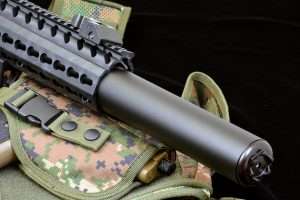
When I say “new” the Sig Sauer MPX and MCX are among the latest military rifles, having been introduced late in 2014. Selective fire versions were developed for military and law enforcement, as well as semi-auto civilian models. The MPX and MCX were designed to be the most modern and adaptable (modular) military rifles available; light in weight at around 6 pounds (the CO2 version comes in at 6 pounds, 10.5 ounces with the suppressor shrouded 21-inch barrel), and has the same lean profile for ease of balance and quick handling in close quarters. The MPX has a 16-inch barrel making it a CO2 version of the Sig Sauer SBR (Short Barrel Rifle) model.
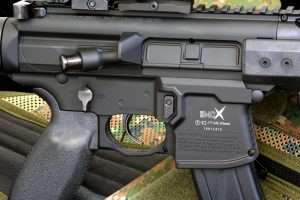
If there was one end result Sig Sauer was seeking with its design for the MPX and MCX, it was a modern day version of its legendary (and still in use) MP5 versions. The rifles were developed for use by Spec Ops and offered to U.S. Special Forces. They were first chambered in .300 Blackout, then in 7.62x39mm and the 5.56x45mm NATO round used in the M4A1 (among other battle rifles in use today by U.S. forces). The U.S. military has not yet adopted the MCX (currently that role is filled by Heckler & Koch’s HK416) and there are still on going developmental changes, including modifications to the bolt carrier group on all current models (a mandatory recall and replacement) and for new production models as a safety upgrade. One can recall the many issues that plagued the M16 when it was first introduced more than 50 years ago, and today it is the foundation for the majority of military and law enforcement rifles, including the Sig Sauer. The HK MCX and MPX are much further along in just their first couple of years than the AR platform was after a decade.
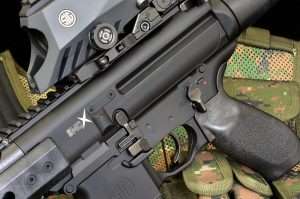
In operation the cartridge-firing MCX and MPX are modular AR hybrids with a short-stroke gas piston design that eliminates the need for a buffer and gas tube; in their place Sig uses a compact recoil system contained completely within the upper receiver, making the rifles more compact with a lightweight tubular stock that can be folded alongside the receiver. For the CO2 versions the Sig design creates a simple, integrated shoulder stock tube to surround an 88 gram gas cylinder, which provides the air rifles with up to 700 fps velocities for 4.5mm lead pellets. This is combined with high-capacity 30-round magazines which operate on a unique rotary internal belt. The pellet magazines look like short (10-round) AR mags.
Externally, the airguns have very similar lines and use the same lightweight skeletonized KeyMod-style handguards. KeyMod handguards are designed with different inner diameters so that they can fit over barrels or sound suppressors as needed. The longer handguard design (as seen on the MCX) acts as a continuation of the one-piece top rail, giving you over 15 inches of accessory rail on the CO2 models. The KeyMod handguards will also accept a variety of accessories including the vertical foregrip that comes with the CO2 model, as well as mounting tactical lights and lasers. On the cartridge models the handguards are designed for quick removal and the Sig uppers can be quickly switched out for different barrel lengths, calibers, and accessories in the field. A bit much for a CO2 version to adopt, so the airguns are standard configurations of the two Sig models, the MPX and suppressed MCX (once again a visual not a functional feature on the CO2 model).
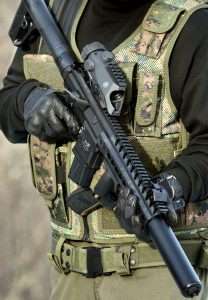
On the cartridge models the fire controls are ambidextrous; safety selector, extended magazine release buttons. and charging handle. On the MCX model, the bolt release is only available on one side of the gun, whereas it is ambidextrous on the MPX. All of this is nice to know but little translates to the air rifle as all of the controls, except for the ambidextrous safety, charging handle, and right side magazine release are functional, the rest are meticulously molded into the receiver and magazine well to look 100 percent real, but not function. Other inert features are the ejection port cover, forward assist and disassembly pins. The flip up front and rear BUIS are fully adjustable and more than adequate for the range of the CO2 model, however, it is optics that really make this new Sig Sauer 88 gram CO2 model perform.
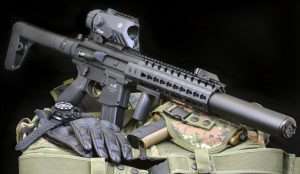
The Sig Sauer MCX ASP is a curious air rifle as there are many advantages to Sig’s ASP design, but the company has thus far continued to avoid superfluous features that serve no actual function on an air pistol or air rifle. This has been the case with the Sig Sauer P226 ASP models, and with the MCX and MPX CO2 versions of their tactical (sporting) rifles.
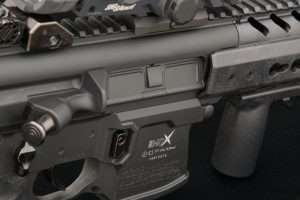
Defining the CO2 Powered Models
The Sig Sauer air rifles are semi-auto only (although as air rifles they could have been equipped with a selective fire mechanism), Sig’s goal, however, is to offer their CO2 models as realistic training guns, as well as for recreational use. Sig Sauer’s Airgun Division vice president and general manager, Joseph Huston explained that, “The industry has truly embraced our ASP air rifles and air pistols as excellent training tools when the cost of ammunition, lack of range time or other factors prevent people from training with their centerfire guns as much as they would like or feel they should.” In that respect, the use of inert components saves on the cost of redundant features or those that have no functional role in the airgun’s operation while not compromising the features of the Sig model, leaving only what is necessary for basic handling and firearms training. Personally, I think the closer an airgun intended for training is to its cartridge-firing counterpart the better (and I can use the Umarex S&W M&P 40 as a prime example), but taking the MCX at face value, it is exceptionally well built, and Sig puts its designs through a 15,000 round reliability test. Whether or not you agree with the non-functioning features, the design is sturdy and well built.
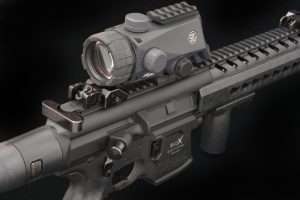
Why Not Selective Fire?
To better understand Sig Sauer’s decision to make the airguns a copy of the semi-auto civilian models rather than the selective fire military version, you need to look at public perception and the debate about what separates a tactical rifle from a sporting rifle. As disparate as this discussion may seem for airguns, it is part of a fundamental debate that has gone on for decades and will likely never be resolved in the minds of many. But from a purely technical standpoint a tactical rifle (those used by military and law enforcement and not readily available to the public) have one overriding feature, selective fire, allowing the gun to continue firing until the magazine is empty, so long as the trigger remains depressed. Thus, a pistol or rifle must have this feature to be an “automatic weapon.” A sporting rifle is only sold to the pubic at large with a semi-auto firing mechanism, and no matter how much alike it appears to a military version, it still requires the trigger to be pulled, released, and pulled again for each and every round discharged. That is the definition of semi-automatic. Those of us who understand firearm’s know this, but this fact is lost on many non-firearms experienced pundits and firearms critics who see a rifle that is not a bolt or lever action design and assume it is an automatic weapon based solely upon its exterior appearance. And mind you, appearances can be deceiving, especially with modern semi-auto rifle designs.
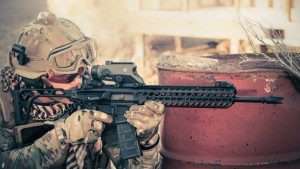
Still, even in the world of law enforcement (with few exceptions) fully automatic weapons are rarely deployed. Selective fire weapons are the purview of SRT (Special Response Teams) SWAT, and the military. When Sig Sauer introduced the MPX and MCX rifles a few years ago they developed military and law enforcement versions, as well as comparably styled civilian models that are only semi-automatic in operation. This very same distinction is still what separates a semi-auto AR-15 Sporter (or any AR platform-based semi-auto rifle used for hunting and sport shooting) from an M16 military rifle, and any other variation of the design used by law enforcement and military. In the world of air rifles, tactical and sporting models share this same distinction but are not limited by it. For Sig Sauer, however, they have adhered to this real world caveat by offering the CO2 powered versions of their MPX and MCX only as semi-auto models.
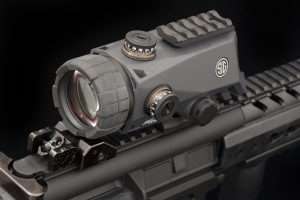
What is more noteworthy about the CO2 versions is the ability to equip them as one would the 5.56mm model, and we begin with the same optics available to both. While it makes little sense to put a $1,299 optic on a $220 air rifle, the fact that you can is what makes the Sig models viable training guns by utilizing the same accessories as the cartridge-firing models. Sig Sauer developed the Bravo4 as a superior sighting system for its tactical and sporting rifles by building it to withstand the harshest environment in the world, the battlefield. It offers an impressive 10 degree field of view which is 43 percent wider than traditional 7-degree optics. Put simply, the Bravo4 provides a 53 foot field of view at 100 yards, versus 37 feet, allowing an operator to see more of what’s surrounding the target. Able to fit any top rail, on any rifle, the learning experience with air quickly and affordably, (at least for the air rifle) enables a quick transition to live rounds. This only makes sense (and dollars and cents) if that is the end goal, but since the Bravo4 was on hand; mounting it on the MCX air rifle seemed like a great place to start shooting the Sig Sauer CO2 model.
Loading the Magazines
Externally, the CO2 Sig has the same lines and nearly same weight and balance as the 5.56mm model. The KeyMod-style handguard also allows mounting other accessories on the sides and bottom, but for this review only the vertical foregrip that comes with the CO2 model is being used. As noted in Part 1 the operating controls on Sig cartridge models are ambidextrous, on the CO2 models this only applies to the safety and charging handle, and magazine release on the right side of the mag well. The magazine itself is one of the airgun’s most outstanding features as it allows 30 pellets to be loaded per magazine.
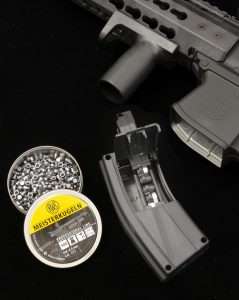
Belt fed pellet magazines are not entirely new, the Umarex Beretta CX4 Storm tactical air rifle uses one, (as will the forthcoming Sig Sauer P320 CO2 pistols), but Sig Sauer’s approach for the MPX and MCX is certainly innovative. If you can picture a belt fed machine gun, you know that the cartridges are inserted onto a belt that feeds the ammo into the action. It’s the same basic principle behind the Sig’s magazine only it is a closed loop design. Opening the side panel on the magazine exposes the pellet belt, which has to move only in a clockwise direction. If you hold the magazine upright with the loading panel raised, always work in an upward direction, as moving the belt counter clockwise (or downward) will damage the internal components. The belt first has to be removed from the magazine which is done by finding the end of the belt (the only portion that does not have white and silver pellet chambers), lifting it off the feeding track and pulling it slowly upward and out of the magazine.
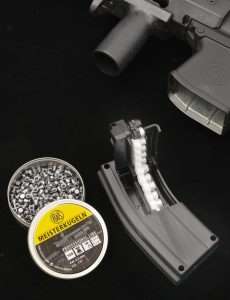
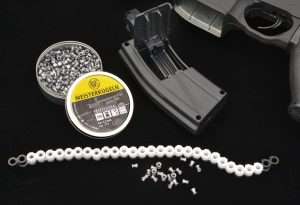
The belt is then laid on a flat surface with the silver portion of the pellet loops facing down. Insert a 4.5mm pellet nose first into each loop on the belt making sure the skirt is flush with the back. Once all 30 have been loaded, the belt is fed back into the magazine (once again going clockwise) until the end of the belt is back in the channel.
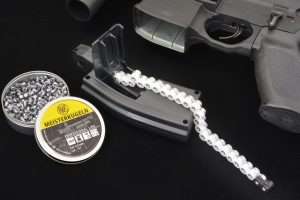
Close the loading port cover, and the magazine is ready to be loaded into the MCX. If that sounds like a bit of work it is, but spare magazines come with three belts, so you can have two pre-loaded in reserve to quickly interchange, as well as extra loaded magazines. It is a remarkably efficient design and the same standard capacity as a .223 (5.56 NATO) AR-15 magazine.
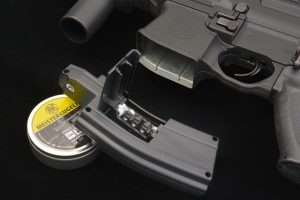
Loading the 88 (or 90 gram) gram CO2 into the MCX is a very quick process by squeezing the release on the right front of the shoulder stock, removing it from the receiver, threading the 88 gram CO2 canister nozzle into the rifle, and replacing the shoulder stock over it.
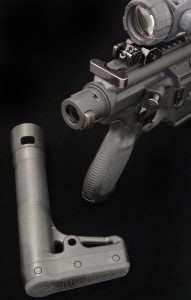
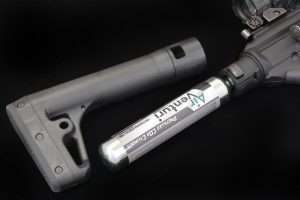
Now that we’re loaded it’s time to sight in the Bravo4 and see what this Sig Sauer air rifle can do.
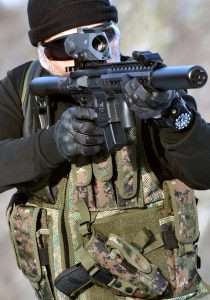


A very impressive replica. I’m still undecided though about whether to buy an MCX or MPX. I thought is might be worth while to wait and give SIG time to fix any problems found in the first couple of years after releasing the MCX and MPX. I’ve also hesitated to buy in order to exercise some “fiscal restraint.”
In this series on tactical air rifles, will you also be reviewing the Daisy Winchester MP4? Or have you reviewed it before in the last few years?
Here’s a related, albeit off-topic question about the new faux suppressor for the SIG Sauer P226 ASP pellet pistols. I know it doesn’t suppress the sound, but is there any data showing that it increases shot fps or improves shot accuracy? Even if the suppressor is just a smooth bore tube, perhaps its additional length gives the CO2 more barrel length to propel the pellet to higher fps. What do you think?
I am not a fan of the 88/90 vi2 cartridges Expendive and other always available locally . Apparently you cannot leave them in for prolonged periods .The HPAC makes the Sig look like a paint ball gun . No thanks .Would like to see a dual 12 gm co2 adapter .This rifle would be better with fully functional not pressed in pseudo controls . Would like to see a larger version of the320 handgun mag in this riflecoupled with select fire capability .
I picked up the Sig 226 177 pellet pistol when it first came out. It is probably a stop gap pistol that will be discontinued . If the mag for the new 320 works , this first gen pistol is gone .Non functioning controls especially slide release, non adjustable rear sight .A big disappointment. Would have thought Sig would have upped the level of play with the rifle platform . I am lefty who shoots handguns lefty and rifles righty. Every serious shooter should practice with and be proficient with both hands, and for that reason ambi controls should be functional or omitted. A nice rifle that with a little more work , could be even better.